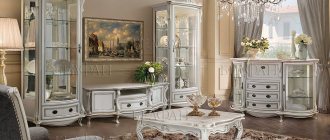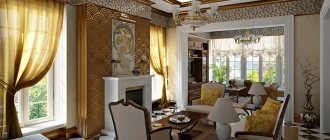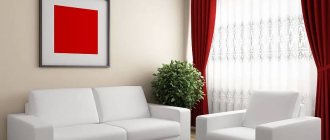Residents of European countries, accustomed to cozy interiors with upholstered furniture, massive wardrobes and chests of drawers, heavy solid doors and many decorative elements, are able to surprise and amaze with the Japanese style with its sophistication and minimalism. In the last decade, this ethnic style has not left the top positions in the list of the most popular interior styles, as it combines impeccable color compositions and strict minimalism, laconic forms and non-standard solutions, naturalness and asceticism. Japanese style in the interior at first glance seems impersonal and lacking individuality, but after a few moments the ascetic and restrained beauty of the room becomes noticeable.
Origin of the style
Japanese style is a folk style of decorating residential apartments and houses in the Land of the Rising Sun. Moreover, since the Japanese are a fairly conservative nation, they managed to preserve and improve the principles and traditions of room design, invented about 5 centuries ago. Sliding bamboo doors, low tables made of natural materials, light curtains and arrangements of dried flowers are elements that are present both in modern Japanese style and, according to descriptions of historians, in the furnishings of the houses of samurai who lived in the Middle Ages.
The Japanese style owes its origin and characteristic features to the specific climatic and natural conditions of the Japanese islands. In the relatively small areas of the islands, which are regularly subject to earthquakes, people could not build stone houses. Indeed, in this case, they would risk being buried under ruins at the first eruption of an underwater volcano. And there was no point in erecting large buildings for the Japanese. Firstly, the territories allocated to each family by the shoguns were not very large, and secondly, people understood that an earthquake could happen any day, which would destroy the results of all their work.
The Japanese style is characterized by the use of natural materials and the minimal presence of metal elements in the interior. This peculiarity of the design of dwellings in the Land of the Rising Sun is explained by the fact that there are very few metal deposits on the islands. In past centuries, steel in Japan was very expensive, and therefore the Japanese believed that it was wrong to spend such a scarce resource on the production of household items.
And of course, the origins and development of Japanese interior style were significantly influenced by the worldview and beliefs of the inhabitants of this country. Restraint, practicality, love of beauty and harmony and the ability to see beauty in details - these traits inherent in the Japanese are reflected in ethnic style.
Since the traditional Japanese home was of a small area, the Japanese style is best suited for small one-room and two-room apartments. This style makes it possible to use every square meter of space with maximum benefit and at the same time create a feeling of space and harmony.
History of style formation
Japanese interior design was formed under the influence of several factors:
- climatic conditions;
- constant fear of a sudden earthquake;
- the dense population of the islands and, as a consequence, small living space per person;
- the stinginess of the earth's interior for natural resources, in particular iron ore;
- national traditions and life philosophy.
The main features of Japanese housing were identified back in the 16th and 17th centuries. It was at this time that a stratum of the population with an average income began to form, capable of luxuriously furnishing their homes. The emergence of a capitalist state structure took place, with clearly defined centralized power.
The country's leadership even more so had the opportunity to equip their homes in the latest fashion. However, this did not happen. Japanese philosophy oriented citizens towards other values. The beauty and pristine nature of the world is the true value, in contrast to all the benefits and achievements of mankind. Such views and preferences led to the fact that the premises were not decorated in a foreign manner, filling them with foreign furniture, carpets, statues and other things.
Traditional furnishings of a Japanese home.
In addition, historically it happened that the geographical location and features of the area contributed to the invention of unique traditions of constructing houses and other buildings. The Japanese built their homes taking into account possible earthquakes. The walls of the house were made prefabricated so that after destruction they could be reassembled like a construction set.
Ancient buildings were also distinguished by a collapsible foundation, which made it possible for the owners to disassemble the house, move it to a new location and reassemble it again. There are no interior walls in an original Japanese house. This is due not only to the likelihood of an earthquake, but also to the desire for free space.
A typical Japanese house.
It was the open layout that made a small home feel spacious. If the townspeople did not have the opportunity to afford a spacious house, and they had to live with a large family in a small home, then they took care of the free space in every possible way. Therefore, Japanese-style design involves the use of a minimum amount of furniture, decor and textiles.
The most related to this style is modern minimalism. Although in a traditional Japanese house there are no clearly designated rooms, the entire area has a pronounced zoning. It is made using multi-level floors and ceilings, bamboo and paper screens and partitions, diffused and accented lighting.
Modern Japanese style differs somewhat from the traditional design of the 17th century. Historical events have enriched the experience and capabilities of the Land of the Rising Sun. The events of the First and Second World Wars, technological and scientific progress led to new construction and design opportunities.
Along with natural materials available in Japan, concrete and metal structures, modern materials that imitate the surface of stone and wood, began to be used. At the same time, the desire for unity with nature, self-knowledge through the external environment, and the vision of beauty in small things remained unchanged.
Interior of a modern apartment.
Design principles and traditions
Interiors decorated in Japanese style are both similar and different from each other. What they have in common is a sense of space, the absence of any unnecessary elements and contrast, and what is individual about them is the combination of colors, decorative elements and features of the division of functional zones. This ethnic style is one of the few styles that combine minimalism, functionality and a strong personality.
The principles and traditions of interior design in Japan have been formed over centuries and have remained virtually unchanged. And the main ones in this style are the following 8 principles:
- Everything superfluous is superfluous. A lot of free space, a minimum of furniture and decorative “trinkets” and the presence in the house of only necessary things are the most important principles of the Japanese style.
- Smooth surfaces only. Floors, walls, furniture and household appliances should have smooth, shiny surfaces. Moreover, you should not put decorative decorations on them, cover them with napkins or place things.
- Only light natural materials. Rice paper, bamboo, light wood, ceramics are materials that the Japanese traditionally use for interior decoration.
- Harmony is achieved through contrasts. Yin and Yang, fire and water, black and white - the balance of opposites is one of the basic principles of Japanese philosophy. This principle is also reflected in the design of housing, so this ethnic style is characterized by a combination of contrasting colors.
- The more light the better. Large windows, light walls, sliding doors with white frosted glass, light-diffusing akari lamps are constant attributes of the Japanese home, designed to make the room bright and visually add space to it.
- Minimum walls and doors. The Japanese style is characterized by dividing space into functional zones using screens, paper partitions, lighting or contrasting colors. In traditional Japanese houses there were no separate rooms at all - the entire space was divided into zones exclusively by paper partitions.
- Live and dried plants are the best interior decorations. Traditional decorations of the Japanese interior include ikebana, bonsai, ceramic figurines, tableware for the tea ceremony, vases, fans and akari. Moreover, other decorations, in addition to bonsai and ikebana, should be present in the setting to a minimum.
- Life on the floor. In Japanese homes, all the furniture is low, and most often chairs, armchairs and beds have no legs at all. Residents of the “Land of the Rising Sun” are accustomed to sitting and sleeping on the floor, so large soft chairs and sofas with many pillows will not fit into the decor of an apartment in this ethnic style.
Traditions
The appearance of a Japanese home has been shaped over the centuries under the influence of numerous factors. The main problem in Japan is earthquakes, which can level a house to the ground in a matter of minutes. To avoid this, walls have long been made prefabricated, and there are no massive partitions in the room at all.
High population density plays an important role. Hence the love for laconicism and minimalism. In search of long-awaited peace and privacy, the Japanese try to free up space by removing unnecessary things and visually expanding the room.
The last (but not least important) decisive factor is philosophy and national traditions, according to which what is happening in the outside world is vanity and is not worth attention. Spacious, bright rooms with a minimum of furniture are best suited for reflection and meditation.
For the Japanese, all that matters is what's inside. That is why it is so difficult to determine their social status - in almost every home there is an ascetic atmosphere.
Color palette
Japanese restraint is fully evident when choosing colors for home decoration. There are no too bright colors or flashy designs; the interior, as a rule, is decorated in a light color palette. Residents of the Japanese islands prefer warm, light colors - cream, light yellow, beige and olive. Darker warm shades are used to create contrast.
As a rule, the interior of one room should contain at least two colors - a basic one, in which all the main elements of the furnishings are decorated, and an additional one, shading the main color and creating contrast. Successful color combinations are collected in the table.
| Base color | Additional color |
| White | Brown, red, burgundy, Wenge wood color |
| Beige | Dark wood color, warm shades of dark red, brown |
| Olive | Dark brown, light brown, white |
| Light pink | Cherry, black, dark brown, Wenge wood color |
| Peach | Warm shades of brown, black |
| Sand | Black, grey, brown-red |
| Light coral | Purple, black, maroon, brown, white |
| Light gray | Shades of dark red, black, dark wood colors |
| Orange | Black, red-brown, white, cherry |
In modern Japanese style, three colors are often combined - one main and two contrasting ones. As a rule, the walls and ceiling, as well as some furniture, are made in the main color, and decorative elements are made in one or two additional colors. The most commonly used combinations are:
- White with black and pink;
- Beige with brown and red;
- Light shades of yellow with black and gray;
- Light brown with white and black;
- Warm shades of brown with white and beige.
Ecological materials are the foundation of style
In order to reflect the island flavor with its inherent features of minimalism, they choose those materials that were available to the indigenous inhabitants of past centuries. Materials that were freely available in nature. They were not exported from distant countries and were not purchased from neighboring countries.
These include:
- cedar, maple, sugi or kiri wood;
- stone tiles;
- reed and bamboo;
- matting and wicker;
- silk.
Even modern Japanese-style designs limit the use of linoleum, vinyl and plastic surfaces. It is permissible to finish surfaces using environmentally friendly artificial materials with a decorative surface similar to natural analogues. For example, for the floor, laminate is selected instead of wood, and instead of natural silk, a more affordable fabric with similar properties is used.
Modern materials in finishing an apartment in Japanese style.
Materials
On the Japanese Islands, natural materials are used to decorate walls, floors and ceilings, and to create furniture and interior decorations - rice paper, bamboo, solid wood of light and dark varieties. Metal and plastics are used to a minimum.
When decorating an apartment or room in this ethnic style, it is better not to use plastic or metal elements at all. Optimally, everything in the room, besides equipment, should be made from natural materials.
Walls
The walls of a room decorated in Japanese style are always plain. They may contain decorative elements - a one-color wall drawing, a panel, a Japanese fan or a minimalist painting. Neither our traditional colored wallpaper nor interior paints are suitable for decorating Japanese-style walls.
An ideal option for wall decoration would be a roll covering made from natural materials (rice paper, wood veneer, etc.). This coating hides all the unevenness of the walls and is absolutely unpretentious in use. But in addition to roll coating, plain wallpaper in white, beige or other warm light colors can also be used as a finishing material. In this case, photo wallpaper with a Japanese-style pattern is glued to one of the walls.
Floor
The Japanese prefer classic wooden floors to modern linoleum and tiles. Moreover, in this style it is better not to use parquet or parquet boards, but simply lay the floor with a board of light or dark wood and cover it with varnish.
The floors in the kitchen and hallway are not covered with anything. And in the living room, bedroom and other living spaces, the flooring is covered with tatami - reed mats stuffed with rice straw or cotton wool. Moreover, tatami should be laid so that the corners of three or more mats do not touch each other - it is believed that this will attract trouble to the house.
If it is not possible to cover all the floors in the living area of the apartment with tatami, you can place mats only near the bed, chairs and other furniture.
Ceiling
The ceiling is decorated in the same color as the walls. It should be smooth and monochromatic, so it is optimal to use suspended ceiling fabrics for finishing. Moreover, glossy and mirrored ceilings in the Japanese style are nonsense, as are the paintings on the ceiling covering. A smooth matte ceiling in the color of the walls is the best solution for decorating a home in the ethnic style of the “Land of the Rising Sun.”
Furniture
Furniture in a Japanese-style home should be made from natural materials and have a minimalist design. Moreover, the less furniture there is in the room, the better. The surfaces of tables, chests of drawers and chairs should be smooth and varnished and match the color of the room's decor. As a rule, the Japanese choose furniture in shades that will create contrast and at the same time harmoniously combine with the main color of the room.
As close to the floor as possible is one of the basic principles of Japanese interior style, which is why sofas, chairs, beds and tables in a Japanese home have low legs or no legs at all. In the center of the house (living room) there should be a table for the tea ceremony, on which a beautiful ceramic set can be placed as decoration.
To store things in Japanese homes, wardrobes with sliding doors are used. The doors and sides of these cabinets should be made in the same color as the walls and ceiling. Sliding wardrobes are placed near the walls in the hallway, living room and bedroom so that they do not stand out in the interior, but “merge” with the wall.
If there are no decorative elements on the walls in the room, it is allowed for the wardrobe door to be decorated with a bright pattern made in the appropriate style.
Furniture
Japanese interior design is suitable for a sitting person, contemplating his inner world, meditating, relaxing at home from the bustle of the outside world. Therefore, all furniture is characterized by earthiness. It’s as if the legs of ordinary wooden furniture were cut off and placed on the floor. The number of furnishings is limited; the fewer, the better. There should be nothing unnecessary in the room.
Traditionally, the house has:
- mats made of straw or matting;
- a low table for tea and food surrounded by small seat cushions;
- instead of a traditional bed, they use tatami or place the mattress directly on the floor;
- the kitchen is equipped with a fireplace and cabinets with closed shelves, behind which all kitchen utensils are hidden;
- For the bathroom, washbasins are often chosen in the shape of a bowl and a traditional wooden ofuro bathtub (or similar in shape).
The room is furnished with simple wooden furniture with straight lines.
Modern bathroom in Japanese style.
Typically, wood was used to make furniture. The higher the position of the owner, the more valuable and expensive the type of wood used. Travel chests, cabinets, and chests of drawers could be made from inexpensive coniferous trees, or, conversely, from strong and durable teak. Expensive furniture was decorated with forged elements and varnished.
At the same time, the cost of the furniture was not deliberate and did not catch the eye. It had a simple shape and lacked any lush decoration. Modern furniture has adopted all these principles; it is distinguished by interesting shapes, squat design and naturalness.
Therefore, when selecting furniture to create a Japanese style in the interior, you can use two options:
1. buy authentic items with a historical past at an antique store or flea market;
2. or select suitable modern analogues from the Japanese collection.
Table and chairs for tea drinking in the living area.
Lighting
The Japanese prefer natural or as close to natural lighting as possible. That is why they use rice paper partitions instead of doors and walls, and the windows in their houses are very large.
Lamps in an apartment decorated in Japanese ethnic style are not hung on the walls or ceiling, but are installed on the floor. Moreover, ideally, you should use acaris for lighting - lamps consisting of a metal frame and a lampshade made of rice paper. They gently diffuse light and provide even, eye-pleasing illumination.
The Japanese also use chandeliers, but the same requirements are put forward for the design of a chandelier as for other interior elements - restraint, conciseness and minimalism. The most suitable for a Japanese-style home would be square or rectangular flat chandeliers, made in one color or decorated with painted hieroglyphs.
Floors
Durable wood, stone tiles, and sea pebbles are used to decorate the floors. You can lay tatami on the floor. The main thing is not to place them crosswise. This is considered a bad omen. The floors are also complemented with carpets made from natural materials - wicker, reeds, coarse thread.
To create a Japanese style in the interior of a modern apartment use:
- light parquet or laminated board;
- self-leveling floor;
- ceramic matte tiles.
Cozy floor with natural flooring.
Accessories and interior decor
Accessories are used to create contrasts and accents. Natural materials are used as decorative elements - dried and live plants, dry branches, stone compositions. An aquarium would also be appropriate in a Japanese-style house.
Accessories and decorative elements should be placed in special niches in the walls - tokonome. Moreover, the Japanese regularly change the decorations in their tokonoma depending on the time of year, holidays or their own mood. And the most appropriate decorative elements in the ethnic style of the “Land of the Rising Sun” are:
- Japanese dolls;
- Ikebana;
- Dwarf living plants;
- Matte ceramic figurines;
- Japanese vases.
It is important that the Japanese prefer to decorate their home not with purchased items, but with items created with their own hands. Moreover, you can make yourself not only a composition of dried flowers, but also a wall panel or drawing.
Decor
Unlike furniture, the choice of decorative items is quite rich. Often the house even has a special place for accessories, designed in the form of a wall niche. Porcelain dishes, a tea ceremony set, engravings, lanterns, netsuke figurines that bring wealth and good luck, and bonsai trees will not only add variety to a minimalist interior, but will also help recreate the mysterious atmosphere of the East.
Japanese interior styling is perfect for people who pay a lot of attention to self-development and value tranquility, solitude and long, deep thoughts. This is an ideal option for those who love nature and want to isolate themselves from the bustle of the metropolis.
However, as you know, the East is a delicate matter, so if questions arise, it is better to seek help from professionals. Our team will be happy to answer them!
Japanese curtains and textiles
Japanese curtains are panels of plain fabric that cover windows like panels. During the daytime, these curtains are assembled in such a way that they become almost invisible. Unlike other textiles, patterns are not applied to curtains.
Knitted and woven bedspreads, rugs and other home textiles are quite appropriate in a home in the style of the “Land of the Rising Sun”. These items also serve to decorate the interior and place accents, so they are decorated with patterns of hieroglyphs, Japanese gardens and nature. It is also allowed to decorate the walls with woven panels with thematic designs.
Textile
Textile interior design makes it unobtrusive and cozy. Select natural fabrics in discreet shades. For example, silk, linen, cotton or mixed fabrics. Traditional drawings that complement Japanese textiles depict views of Mount Fuji, scenes from the life of samurai, hieroglyphs, and the animal world.
Textiles are used to decorate:
- windows;
- sleeping area;
- seating areas;
- screen
Textiles in an ordinary Japanese apartment.
Japanese fan
Large fans made of fabric or rice paper are a traditional decoration of the Japanese home. Such fans depict hieroglyphs, scenes from myths or the nature of the Japanese islands.
A Japanese fan is hung horizontally on the wall so that it is closer to the ceiling rather than the floor. There can only be one fan in one room, and such wall decorations are not used in the bathroom, kitchen and hallway.
Ceilings
The color and shape of the ceilings corresponds to the general style:
- it must have a clear shape, for example, a rectangle or triangle;
- the color of the ceiling can match the color of the walls;
- Wallpaper, matte paint, stretch fabric or hanging panels are used for decoration.
To highlight one or another zone in an open plan, the ceilings are made in several levels, finishing each zone differently.
White painted ceiling, equipped with wooden beams and slats.
Japanese partitions
Japanese-style partitions serve to separate functional areas. They are made from bamboo and rice paper and are easy to put away and rearrange. The color of the partitions should match the shade of the walls and ceiling. It is allowed to apply thematic drawings to the partitions.
You can also use fabric screens as partitions. Most often, screens are made of silk and other light fabrics that can transmit light.
Colors
To create a distinctive Japanese-style room design, rely on pure colors.
Original Japanese colors:
Halftones are not welcome; bright contrasting color mixtures are not used in interiors. Japanese philosophy strives for order, so it tries to eliminate chaos in everything. To get a beautiful interior, it is enough to use one pure color in combination with natural surfaces of wood, bamboo or stone. For example, the beauty and structure of wood is perfectly emphasized by white color. Against its background, a network of annual rings and knots can be seen. To enliven a calm color scheme and emphasize the main areas of the room, pure red is used. This is the color of strength and masculinity.
A harmonious combination of white and natural wood with an accent of red.
To create a feeling of peace and harmony with the outside world, dark colors are also used. Most often, this effect is achieved through the structure of darkened wood in combination with black furniture. A dark Japanese-style interior is not as common as a light one, but it is quite acceptable. The main thing is that the condition of geometric order be achieved.
Geometrically organized space in dark colors.
Bedroom interior
In the bedroom you need to place only the most necessary pieces of furniture - a bed, a chest of drawers, one or two chairs and a lamp. The chest of drawers, bed and chairs should be low, and if there is a podium in the bedroom, you can put a bed on it without legs or simply put a mattress with a rigid frame.
Light silk curtains are hung on the window in the bedroom, and compositions made from natural materials are used to decorate the room. To make the room more comfortable, you can decorate the bed and chairs with silk pillows with hieroglyphs painted on them. Also, a picture or fan is often hung above the bed.
The bedroom floor can either be completely covered with tatami or left uncovered. But in the second case, a rice straw mat should be placed by the bed.
Basic color combinations
Natural shades abound in the interior. Bright colors are allowed, but they should not hurt the eyes. Saturated shades are used for decorative elements, and not as a background. It is best to make all surfaces monochromatic so that they do not draw undue attention to themselves, distracting from the details. Best for background:
- light shades of brown;
- beige;
- coffee;
- lactic;
- ivory (ivory);
- cream;
- grey.
For furniture and accessories, more saturated shades are used, but, again, not beyond naturalness. Upholstered furniture, ottomans and pillows can be red, dark brown, green or crimson. Wooden parts can be walnut, ivory or made to look like red wood. Wood coated with black varnish looks good.
Also, when decorating a Japanese living room, you can use warm autumn colors: rich green, crimson red, red, sand, shades of mustard, tobacco. Black and white interior design also does not go out of Japanese style.
Living room interior
A typical living room design in a Japanese house is a spacious, bright room decorated in a minimalist style. The walls in the living room are always light, warm colors, and the floor is covered with tatami. There should be a minimum of furniture in the room - a low table for tea drinking in the center, one or two compact sofas near the walls and several low chairs. It is better to hang the TV on the wall rather than buy a separate stand for it.
As interior decorations, you can use compositions of dried flowers and branches, ceramic figurines, dolls, fans, panels and wall paintings. But it should be remembered that decorative elements should be combined with each other and not take up space. It is optimal to place them in niches in the walls or in the corners of the room.
Wall decoration
A unique feature of Japanese interiors is the absence of internal partition walls. Instead, they use lightweight structures made of fabric, bamboo or thick rice paper on a wooden frame. They help to zone the room.
The story with the outer walls is even more interesting. In the usual sense, they simply do not exist in a Japanese home! The design of a traditional home consists of wooden columns and a roof connected by movable panels. However, this option is not suitable for the Russian climate. What if it blows away with a light spring breeze?
As for our native walls, they can be upholstered with fabric, wood, trimmed with stone, covered with light paint or plaster.
Children's interior
A children's room in a Japanese house is also decorated in a minimalist style, however, when creating the atmosphere in this room, it is permissible to use brighter colors and interior decorations intended for girls and boys. For example, you can decorate one of the walls with photo wallpaper or a picture of your child’s favorite cartoon character.
Furniture in a child's room usually includes a comfortable low bed, a table and chair, a wardrobe or wall shelves, and a chest of drawers. When decorating a room for a boy, gray or olive is most often used as the base color, and for a girl, beige or pink.
Also, when decorating a nursery, one should not forget about the traditional decorations made from natural materials and lamps for this style. But in the rooms of preschool or primary school children, it is better not to place lamps on the floor, but to hang them on the ceiling.
Room interiors
Let's take a closer look at the interior of each room. What is best to use and how, and what is really not necessary.
Bedroom
A Japanese-style lounge is an organic and original solution. The selection of materials and furniture begins with determining the dominant color. In addition to it, you can choose several harmoniously combined shades.
Advice If the bedroom is very small, then it is best to make the floor white (for example, from bleached wood). This technique will visually expand the space.
Bedroom – harmoniously combining elements
The following colors are suitable for the bedroom:
- grey;
- cream;
- white;
- black – less often.
Soft diffused light is created by using lampshades made of paper, frosted glass, and fabric.
Light colors are suitable for the bedroom
When decorating a bedroom, you can follow the following recommendations:
- The use of wallpaper (including bamboo) and photo wallpaper with ethnic prints.
- Wooden panels.
- Plain fabrics on the walls.
- Minimalist bedside tables.
- Arrangement of only necessary furniture. Nothing extra.
- Built-in wardrobe with sliding doors.
- Screen curtains, the shape of which is emphasized by weights in the lower and upper parts.
- Suspended ceiling, frosted glass inserts are possible, creating a beautiful “moon sky” effect.
- Built-in lighting.
Minimal bedside tables
Expressiveness and conciseness are given to the room by accessories. There shouldn't be many of them. These could be paintings, fans on the walls, bonsai in pots, dolls in national costumes, etc. A bright accent can be made on the design of the bed if you use a bedspread with hieroglyphs or red pillows.
Advice If the bedroom is not a separate room, then its selection can be done by using screens.
Children's
Japanese style prefers light colors, which is a plus when decorating a child's room. Natural shades and natural materials allow you not only to emphasize style, but also to create an environmentally friendly, healthy interior.
Adding light shades
Plain walls in calm colors can be complemented with photo wallpapers depicting characters from Japanese fairy tales or views of Eastern nature. For girls, you can choose prints with cherry blossoms, weaving roses, and delicate flowers.
It is advisable to select furniture by adhering to the following principles:
- a comfortable comfortable bed, which should preferably be located in the central part of the room;
- the workplace should be functional and well lit;
- screen - to separate the recreation area from the play area;
- a wardrobe with sliding doors that can be organized as a built-in one;
- The shelves are necessarily wooden, but quite light.
When choosing furniture, we adhere to the basic principles
Accessories depend on the gender and age of the child. Preference should be given to those that are made from natural materials and emphasize the style: national dolls, figurines, etc.
Living room
This room is central in the house, intended not only for relaxation and communication between family members, but also for meetings with friends and business partners. Therefore, when designing, all specifics must be taken into account. A neat, bright room with a minimal set of items and unusual styling will not leave guests indifferent.
The living room may have a greater presence of black than other rooms. The rich dark color looks solid and adds significance. But even in the living room there should not be too much dark color.
We emphasize the importance of style with every detail
Natural light shades still remain predominant:
- beige tones;
- white;
- ivory;
- natural shades of wood;
- grey.
To emphasize respectability, preference should be given to natural materials rather than their imitations.
It is better to choose natural materials for finishing
For a studio apartment, the living room area can be organized on a low podium. Additional highlighting is created by color (of the floor, walls, ceiling, furniture), and the organization of lighting.
The minimum set of furniture should include only the most necessary items. A tribute to the times - household appliances, which should be organically integrated into the decor so as not to stand out. If there is a workplace in the living room, it can be separated with a Japanese-style screen.
Tall comfortable chairs and bulky sofas should be replaced with simple ones that are more ascetic in shape and design, which may seem uncomfortable if you are not used to it. Storage systems can be built-in, equipped with sliding doors. For those who have their own library, we can recommend organizing the storage of literature in artificial niches organized directly in the walls.
Replace with simpler and more comfortable furniture
Advice If there is a lot of equipment and it disrupts the overall harmonious picture, it can be separated using a screen.
The decor of the living room should be restrained and strict . Family photographs and souvenirs from vacation spots cannot be placed here. Neutrality is one of the main requirements. For decoration it is possible to use paintings on the walls, antique vases, bamboo.
Bathroom
The laconicism inherent in the entire design should also be seen in the design of the bathroom. A traditional bathtub is made of wood, hollowed out and processed using a special technology.
Beige and brown - a beautiful duet
Current trends allow you to compromise and use conventional bathtubs. But installed on a wooden podium or with stone decoration. The washbasins are a smooth oval shape, with a wooden countertop underneath.
The same minimalism is observed in relation to showers:
- simple glass partitions;
- there is a drain hole in the floor;
- simple organization of taps and shower.
Beautiful bathroom design
In the bathroom, it is quite acceptable to use photo wallpaper depicting thermal springs, bamboo, sakura, and landscapes typical of Japan . It is only necessary to take into account that such wallpaper must be moisture resistant, designed for gluing in rooms with high humidity.
Hallway
The first impression of the home begins to form in the hallway. The color scheme is pleasing to the eye and natural. This is a wide range of brown shades, gray. Additionally, bright colors in the form of accents. Organizing a small space in Japanese style requires the compactness of the items used. For decoration, a floor vase, a painting in a simple frame, or an image of hieroglyphs are suitable.
Color scheme in the hallway
The hallway should not be filled with objects. The organization of free space should correspond to style and take into account functionality. Storage of things can be organized using a wardrobe. But in itself it should not be bulky. Its facade should be neutral or have decor in the form of an image of Japanese nature.
It is better to replace lush poufs and elegant banquettes with modest benches made of wood or bamboo. Such a piece of furniture will become a decoration of the hallway in itself. If soft upholstery is preferred, then linen, cotton, silk or suede can be used.
We don’t fill the hallway with furniture
Wood or high-quality laminate can be used as a material for Japanese-style flooring. In this case, something made on a bamboo base will look interesting and unusual.
The hallway should have good lighting. This can be a large, but at the same time light lamp that matches the interior. The glass shade is often decorated with a Japanese-style pattern.
Advice In lighting fixtures, it is advisable to provide the ability to change the lighting intensity.
We make good lighting in the hallway
Kitchen
Arranging a Japanese-style kitchen requires wooden furniture and clear geometric shapes. The furniture set should have strict facades, devoid of decorations. Only inserts of frosted glass elements are allowed. It is advisable to choose hidden handles.
The selection of a dining table is based on the size of the room. If there is a lot of space, the table is placed in the center of the room, giving preference to a fairly massive model.
If there is not enough free space, a lighter structure can be placed. Chairs should be solid and have a streamlined shape.
Kitchen decor - minimal
Kitchen lighting should be sufficient, but diffused. The lamp shades are of simple shape (sphere, cube, etc.).
In addition to frosted glass, the following material can be used to make Japanese-style lampshades:
- rice paper;
- jute;
- tree;
- branches;
- straw.
We place everything practical and compact
Kitchen decor is minimal. Let's say a scroll with hieroglyphs on the wall, vases in a niche, ikebana, ethnic engraving. An additional decoration of a Japanese home are living plants:
- bamboo;
- orchids;
- bonsai.
VIDEO: Incredibly beautiful Japanese interior
Japanese style
We create a beautiful design
Bathroom interior
The bathroom in a Japanese house or apartment is a place for rest and relaxation. The walls in the bathroom are most often either light, plain, or decorated with bamboo or rice straw. This room should be divided into three functional areas:
- Changing area separated by a screen;
- Area with shower;
- Area with a bathtub completely hidden in the floor (ofuro).
Ofuro can be either square, rectangular or oval in shape. This bath is made only from wood. According to Japanese tradition, before going to bed in the ofuro, you must take a shower.
If the apartment has a small bathroom, you can divide it into two parts with a screen: a changing area and a shower room. In both large and small bathrooms, decorative elements made of matte clay and ceramic wall tiles with Japanese-style designs will be appropriate.
As lighting for the bathroom, you can use several spotlights that diffuse the light and fill the room with a soft, even glow.
Examples of Japanese-style interiors
Japanese style design is not suitable for all rooms. The best solution would be to arrange this area in spacious rooms where an open layout is expected. Studio apartments and simply large rooms are the most successful option. But there are also examples where the room is small, but its design was played in the spirit of Japanese culture.
On a note! It should be remembered that the minimal presence of furniture and decor will not create natural sound insulation. Partitions and screens perfectly transmit sounds.
With the help of screen curtains, screens, and sliding interior partitions, it is easier to zone a room. Other styles may be characterized by zoning using furniture and lighting. But in Japanese interiors, partitions, screens and roller blinds cope well with this.
Bedroom
The bedroom is considered a room where laconic furniture or decor is allowed. Therefore, a Japanese-style room design is suitable here. Seemingly fragile partitions, screens, modest curtains, a minimum of bedside tables and chairs, a small low dressing table - these are its main elements.
Note! You can often find in a space furnished in Japanese a two-level (or 3-level) horizontal surface. It is present in the design of a suspended ceiling or arrangement of a sleeping place in a spacious bedroom. The bed in this case is on a hill.
Kitchen
The practicality of Japanese style in the interior allows you to create a functional and stylish kitchen. Squat furniture, natural textiles, roller blinds on the windows, and mats on the floors are perfect here. All dishes must be put away in cabinets. The main thing is not to forget that the Japanese style will require a small number of wall cabinets, tables, and classic chairs. Minimalism will help preserve free space.
Orange in Japanese interior Source www.alimpia-mebel.ru
Note! The facades of the kitchen units are simple, without milling, moldings or other decorations. From a distance, wall cabinets resemble drawers, chests or caskets.
Kitchen in black and red Source akuhnja.com
Children's
A Japanese-style children's room well combines practicality, functionality, cuteness and romanticism. Light colors feel comfortable to a child. They can be played out in different themes, close to Japanese comics, fantasy or cartoons. Photo wallpapers with a Japanese theme for children look especially beautiful. The same rules are followed here: low furniture, a minimum of decoration, furniture functionality and maintaining minimalism in the Japanese style.
A cute theme has been introduced into the Japanese style of the children's room Source dizainexpert.ru Children's room in Japanese anime style Source corner.com.ua
Note! You can zone a child's room using sliding partitions, roller blinds, screens or straight curtains (without ruffles or bows).
Living room
For dining rooms or living rooms, you can already select different shades - from light to dark options. The rules for using contrast techniques must be taken into account. Even if the interior is planned in dark colors, it is easy to diversify it with red decorative elements. Freedom of space is the main thing in a Japanese-style living room. Therefore, we choose only low, cubic and simple furniture. We don’t clutter the room with unnecessary things – we leave only the essentials.
Interior of a living room in Japanese style Interior of a small living room in Japanese style, which easily turns into a bedroom Source valentaymbud.com.ua
Bathroom
When designing a bathroom, you can use stone, ceramics and bamboo. The main thing is to carefully select patterns and harmonics of the color palette. Details such as simple candlesticks with candles, floor lanterns, a stone washbasin, a pair of miniature vases are suitable here. A well-thought-out Japanese style in the interior should create Buddhist tranquility.
Laconic bathroom interior design in Japanese style Source sovety-vannoy.ru
Hallway
The room should be functional. The lighting is dim. It doesn’t matter what size the room is, it’s better to have sliding doors. The hallways will look convincing in Japanese style if the ceiling is framed with slats and thin beams of a dark color. At the same time, the canvas between them is light. Floor or wall paper lanterns, engravings on the walls, and a huge fan are a must. The wardrobe or hanger here also needs to be equipped with a closing sliding panel.
Hallway in Japanese style Source sky-lion.com
Kitchen and dining room interior
The kitchen and dining room in Japan are one room divided into two zones. Food is prepared in the “kitchen” area, so all the necessary equipment is installed there. Since the Japanese prefer minimalism and functionality, their kitchens have no place for massive appliances and many cabinets. When decorating a kitchen in the Japanese style, built-in kitchen appliances and one or two spacious kitchen cabinets made of wood are used.
In the eating area there is a table with chairs. Like all other furniture, the kitchen table should be low, and mats can be used instead of chairs. During meals, the table is covered with a plain tablecloth or mat.
The main color for decorating a kitchen can be either a light or dark shade. As decorative elements in this room, designers recommend using floor vases, sophisticated plain sets, wall panels and rice paper lampshades.
IMPORTANT: Traditional Japanese curtains are not hung in the kitchen. Instead, light white or beige cotton curtains are used.
Dishes
In everyday life, the Japanese use ceramic dishes made in simple rectangular, round or triangular shapes. For everyday meals, plain dishes are used, and on holidays the table is set with sets.
A Japanese-style kitchen must have the following utensils:
- Van - deep, but small dishes with a lid for rice and first courses;
- Khati - shallow, wide serving bowls for main courses;
- Chawan - tea bowls;
- Katacuti - bowls with a spout for sauces;
- Tyatsu - bowls on a foot for side dishes;
- Dobin – teapots;
- Bon - round or square trays.
Peculiarities
The three pillars on which the traditional Japanese interior is built are spirituality, brevity and minimalism. Following these principles helps to brilliantly manage the organization of empty space.
The main features of the interior in Japan also include:
- natural motives
- use of natural materials
- natural color scheme
- low furniture of regular geometric shapes
- lack of internal walls
- minimum decor
- diffuse light
Hallway interior
The hallway, as a rule, is decorated in a darker color than the living room. This room should have a minimum of furniture - one or more compact sofas, wardrobes, shelves for shoes, and perhaps a dressing table made in a minimalist style with a large mirror.
It is best to use bonsai and floor vases with bamboo as decoration for the hallway. The walls of the room can be decorated with paintings of nature, panels or a composition of dried leaves and flowers.
Walls
Natural materials or their various combinations are used for wall decoration. For example, a room may have wood paneling around its entire perimeter. Or wooden slats are effectively combined with smooth plastered and painted walls in pastel colors. Also, walls with masonry can be interspersed with areas covered with paper wallpaper. Smooth walls are decorated with paintings or engravings depicting nature.
A modern version of wall decoration.
How best to decorate walls and floors
You need to choose materials for walls and floors carefully. Despite the fact that they are most often monochromatic, these surfaces are visible immediately upon entering the room and occupy a significant area.
Important: Follow the color combination rule. Light shades are used for the walls and ceilings, while the floors are painted dark.
You can finish the floor with light-colored materials, but it should still be at least one tone darker than the wall covering. For example, if the walls are white, then beige is suitable for the floor. To make the design of the walls and ceiling look more elegant, the main color can be diluted with an additional, more contrasting shade in a ratio of 80%/20%.
Walls and ceiling without decoration. Let them have Japanese characters or traditional paintings and drawings. An economical and stylish option for wall covering is wallpaper that imitates bamboo and is complemented by several designs in the classic Japanese style.
For the ceiling it is better to take white and its shades. The best option is tension structures with images of hieroglyphs or a small Japanese image. If you want to use laminate flooring, choose a pattern that imitates bamboo. This is an economical option that does not stand out from the general style.
Choice of textiles and textures
Since closeness to nature is important for the Japanese style, the materials should be natural.
Important: the entire effect of the interior can be negated due to the use of plastic and synthetics.
Basic materials:
- linen and cotton are used for furniture upholstery and curtains;
- furniture frame, wall decoration and flooring - natural wood;
- blinds and decorative elements (wind chimes, indoor fountains) are made of bamboo;
- screens and lampshades for lamps - rice paper;
- decorative elements and floors can be stone;
- if dishes are used in the living room interior (for example, the room is combined with a kitchen), it is better to give preference to ceramic products;
- boxes and chests woven from real willow twigs;
- glass is used in the form of dishes, table tops or decorative elements;
Furnishing a Japanese living room
Japanese style is minimalist, furniture is used only when needed, therefore, there should be as little of it as possible. There are no useless furnishings in a Japanese living room. Everything has its own function, or even several. At the same time, this does not mean that you need to give up soft sofas and sit on the floor. When choosing upholstered furniture, pay attention to low and compact models. Sofas and poufs should be squat and as if pressed to the floor.
There is no need to install bulky sideboards and cabinets in a Japanese living room. Where to store things? The solution is extremely simple - sliding wardrobes. They are practical, compact and do not draw unnecessary attention to themselves.
Don't forget about accessories that are unique to Japanese homes. Such decorations diversify the interior and bring a unique national spirit to it. As decoration you can use:
- katanas on the wall;
- large painted paper fans;
- vases;
- figurines of geishas and samurai;
- maneki-neko cat figurines;
- bonsai;
- paper lanterns, etc.;
The living room, decorated in accordance with the Japanese style, is suitable for people interested in oriental cultures and exotic interiors. The Japanese coloring in the interior looks bright and rich; the living room will be interesting both to spend time with friends and to relax quietly while reading books.











